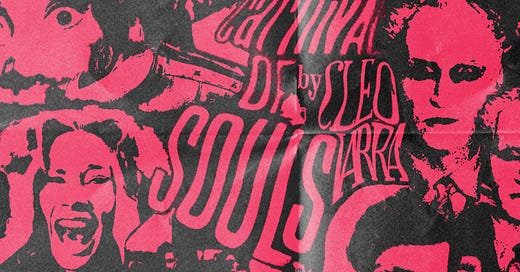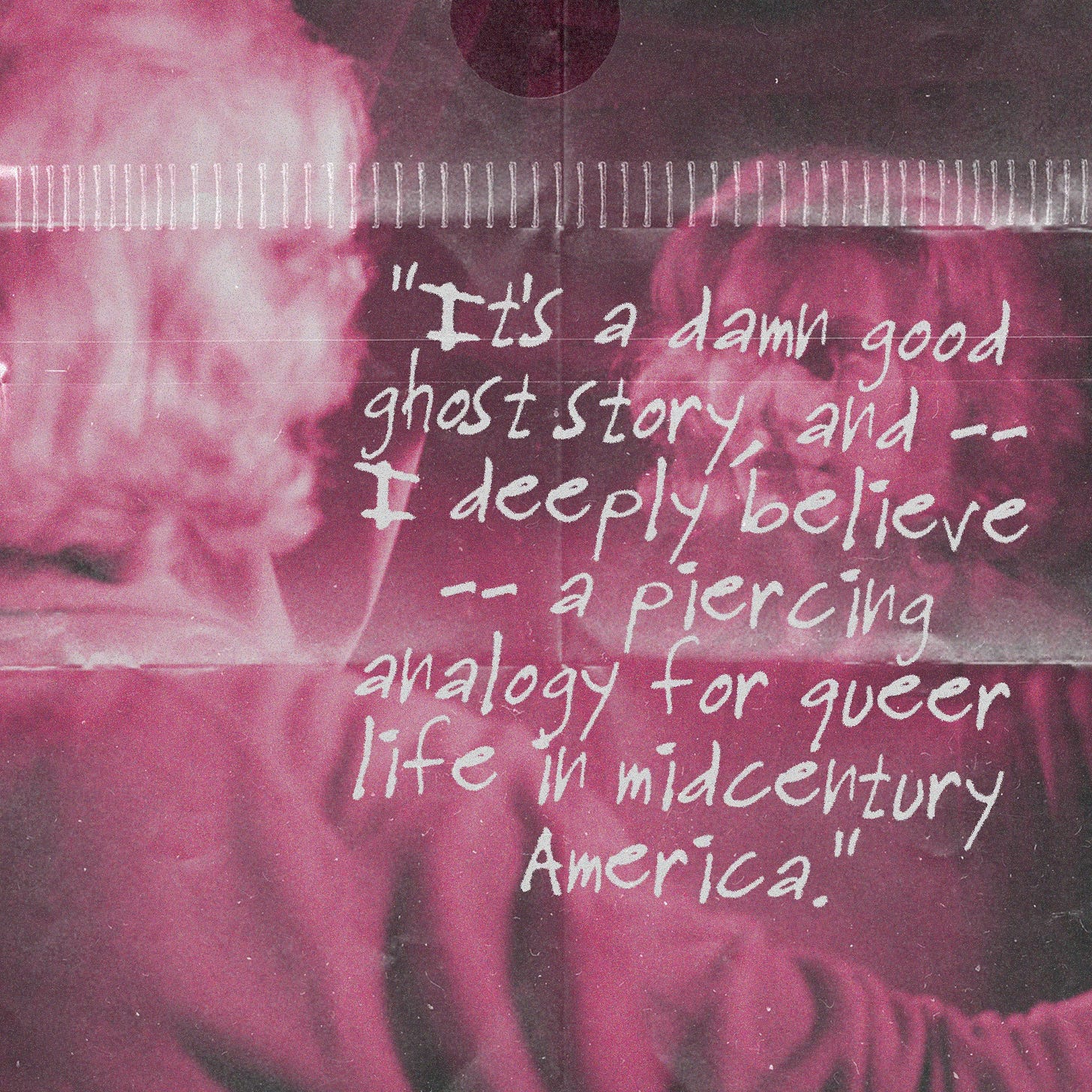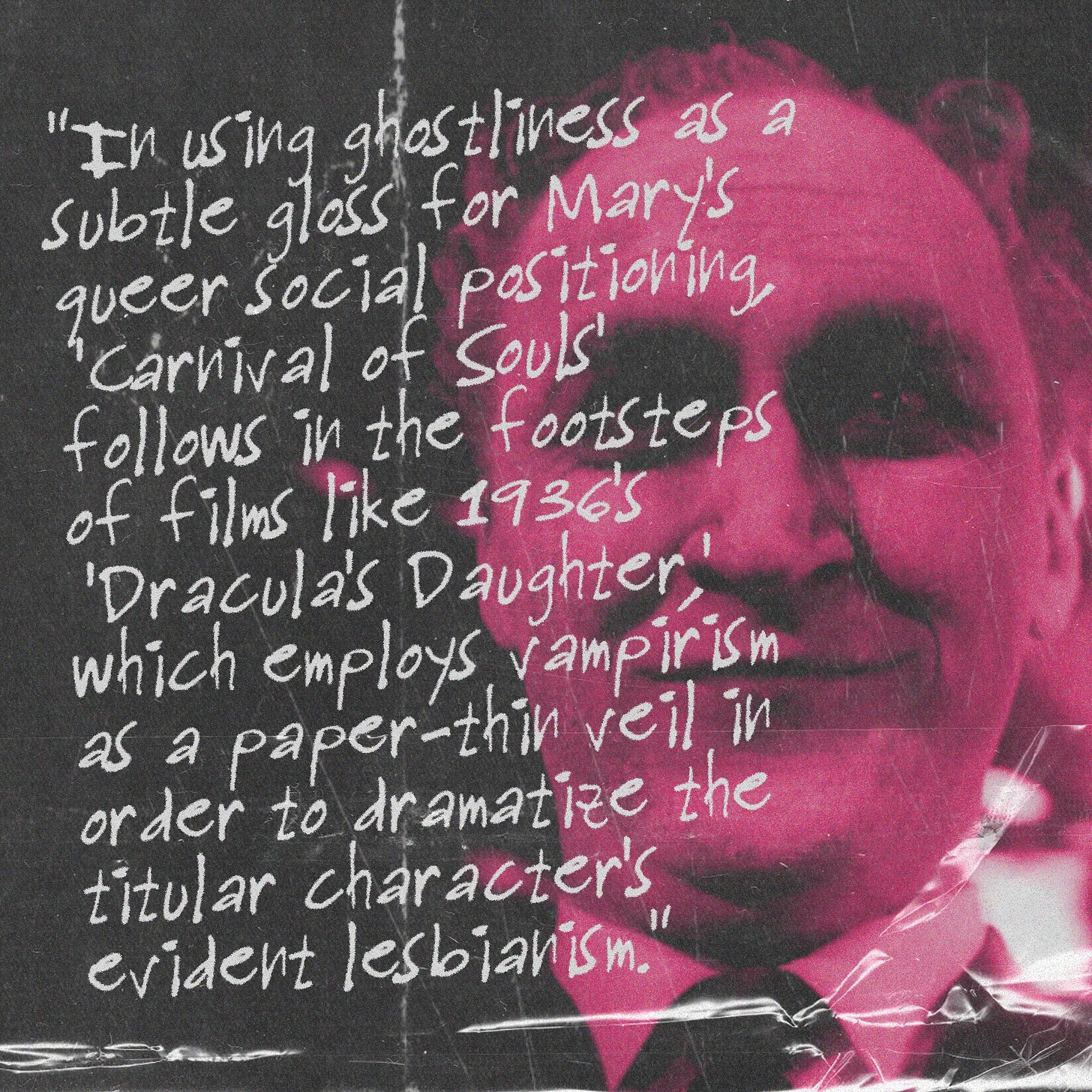“Carnival of Souls” is a B-movie classic from 1962. It was made by two industrial filmmakers who had seen the early imports of Ingmar Bergman films and decided to make something that was as atmospheric, as taut and minimalistic— but then did so with skills honed via 1950s-era educational socialdrama shorts. It’s a damn good ghost story, and — I deeply believe — a piercing analogy for queer life in midcentury America.
The film opens with its protagonist, Mary, drag racing with two of her female friends against a rival car of boys. They have a good head start on the fellows, until they crash off a bridge into a river. Mary is apparently the only survivor. Soon, she’s back to her normal life: playing eerie tunes as a solitary-minded church organist. It’s on her way to Utah, accepting a new church organist position, that she first sees “The Man” — a ghoulish figure in fabulous makeup, who materializes in order to gaze at her blankly through the passenger side window. He appears again on the road in front of her – doing nothing in particular, just standing in his dark, smoky eyeliner – and causes her to run off the road once more. Still: it has to be said that the biggest pests around her are, without fail, fully living human beings. Namely, we have the insufferable Mr. Linden — her neighbor in the apartment across the hall, who will not stop asking Mary for a date, leering and licking his lips as she puts on her bathrobe. “You’re going to need me in the evening too,” he promises. “You just don’t know it yet.” “I can’t accept,” says Mary, flatly. Indeed, she cannot: because when she rethinks her refusal, and goes across the hall to knock on Linden’s door, a mysterious force prevents her from performing this heterosexual act — a mysterious force in the shape of The Eyeliner Man! What is a girl to do?
Much more intriguing to Mary than Mr. Linden is the pavilion on the edge of town: an old bathhouse that was made into a dancehall before falling into disrepair and eventual dereliction. Now all that remains within are charming party decorations, fluttering gently in the sea breeze. “What attraction could there be for you out there?” asks a priest, who notices Mary’s interest in the place. “The law has placed it off limits.” “I’m not sure,” she replies – “I’m a reasonable person”; yet the forbidden dancehall seems to be calling to her, ineluctably; and, after the killjoy priest convinces her to leave without visiting it, The Eyeliner Man again appears in the pavilion’s window, sadly lowering his head as she drives away. Don’t worry, my guy; I have a feeling that she’ll come around eventually.
As Mary is in town shopping for dresses, she has a strange episode: the camera goes all wavy, and suddenly, it is as if the people around her are incapable of acknowledging her presence. Talk about invisibility! Shoppers bustle through the clothing racks, thoroughly ignoring her as she hovers behind them anxiously: “What’s the matter with everyone? Why don’t they answer me?” Just as quickly, the spell is broken, and – fortunately or unfortunately – a distraught Mary is approached by a passing psychologist, who diagnoses her as having “had a fright”, and offers to see her in his office immediately. What, no waitlist? The past really was utopia.
In his office, Mary explains: “It was as though for a time I didn’t exist.” She looks off into the distance. “As though I had no place in the world, no part in the life around me.” Babe, you just gotta find your tribe. The psychologist asks: “Anything else? Anything you… haven’t told me?” He presses her: “Do you have a boyfriend, here, or back home?” “No!” cries Mary in disgust, “and I have no desire for one.” The psychologist is intrigued: “Never?” “No,” Mary says again. “I’m surprised to find myself saying that, but it’s true.” The psychologist leans in; he’s onto something. “Have you always felt this way? Don’t you want to join in the things that other people do, share the experience of other people?” Yawn. Mary answers: “I don’t seem capable of being very close to people.” “Do you feel guilty?” asks the psychologist, and suggests that maybe The Eyeliner Man represents a guilt feeling. “Oh,” snaps Mary, “that’s ridiculous!”
But ghastly Mr. Linden from across the hall seems to be picking up on a similar vibe. “What?” he asks, “are you afraid of men? You seem kind of cold.” But I wouldn’t say that Mary seems cold: rather, she’s interested in entirely different things – things like playing the film’s creepy theme music, barefoot at the church organ, while fantasizing about the pavilion and glancing around at the stained-glass windows that read, “cast out devils”. It is night, and a whole host of fabulously made-up, smoky-eyed dancers are emerging from the waters around the pavilion, to twirl and twirl among the shimmering party decorations. Mary can’t keep her mind off of them. Eventually, the tiresome priest intervenes again, looking scandalized as he clamps her hands down on top of the organ keys. “Profane!” he cries. “Sacrilege! What are you playing in this church? Have you no respect? Do you feel no reverence? I feel sorry for you. And your lack of soul.” Um, have they never heard the phrase “open and affirming”? Apparently not: the priest fires her on the spot, then calls after Mary as she sadly gathers up her book of Great Organ Classics: “This does not mean that I am abandoning you, nor should you turn your back on the church. There is help here, and I urge you to accept it.” Yeah yeah yeah, go fall off a bridge, why don’t you?
Mary’s day isn’t over yet: outside of the church, creep supreme Mr. Linden is waiting impatiently for the dinner date that she has finally promised him. At the straightest bar in town, music blasts from the jukebox as Mary sits beside him, nursing a glass of water and looking entirely disinterested. “You don’t like to dance,” whines Linden, “and you don’t like to drink, and you don’t like for a man to hold you close: that’s it, isn’t it?” Mary protests: “I didn’t say that!” You didn’t have to, babe; you didn’t have to. Back at the rooming house, Linden continues to neck and paw. She breaks away, and then – what luck! — frightens him out of her room via The Eyeliner Man, who appears in a mirror. Mary screams, and Linden says those magic words: “I’m getting out of here.”
This frees her time up nicely. The screen goes wavy again, and again Mary slips into that state of reality in which it is almost “as if [she doesn’t] exist.” She runs and runs through the streets, but there’s no escaping her situation: that she is queer – I mean dead – I mean that, oh my goodness! Mary’s been dead this whole time! Still in desperate denial, she runs onto a waiting Greyhound bus, and is greeted by seats full of heavily made-up, smoky-eyed ghosts, who reach towards her, embracing her. But she’s just not ready to accept the truth. Mary is deep in the ghost closet. “Why can’t anybody hear me?” she wails, pushing through throngs of oblivious normies. In despair, she drives back to – where else? — the abandoned pavilion. The ghosts pop up out of the lake, and, as Mary looks on, begin once more to dance. The Eyeliner Man spies her from across the crowded room, and the camera cuts suddenly to Mary, who is finally wearing the same pancake makeup, dark lip, and smoky eye as her otherworldly comrades. The Eyeliner Man smiles proudly; they waltz, and, as he dips her to the ground, Mary – for the first time in this film – finally smiles. Of course, the film must simultaneously disavow this evident desire for otherness: the camera cuts back to Mary, sans makeup, watching herself; she screams, and tears at her hair in frustration. She makes a dash for the door, but the ghostly partiers won’t let her go so easily. They chase after her. Laughing delightedly, they run through the abandoned boardwalk, popping out from behind wooden columns and briny bushes to greet her every which way. For an instant, Mary appears to be laughing along with them; then she screams once more, and vanishes. Phew. It seems that they finally claimed her for their own.
In using ghostliness as a subtle gloss for Mary’s queer social positioning, “Carnival of Souls” follows in the footsteps of films like 1936’s “Dracula’s Daughter”, which employs vampirism as a paper-thin veil in order to dramatize the titular character’s evident lesbianism. Because how else, in 1962, are you supposed to reference queer traits – seductive forbiddenness; social alienation; disputed existence – without turning to the supernatural as a mournful, fantastically poetical device? I can only hope that in the “Carnival of Souls” sequel, which should be made immediately, our Mary can find more self-acceptance within her ghost identity. Dance on, sister. Dance on.








